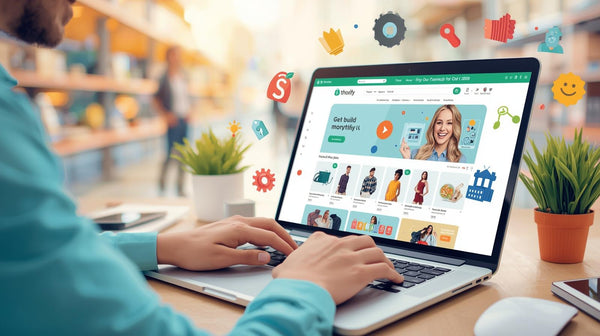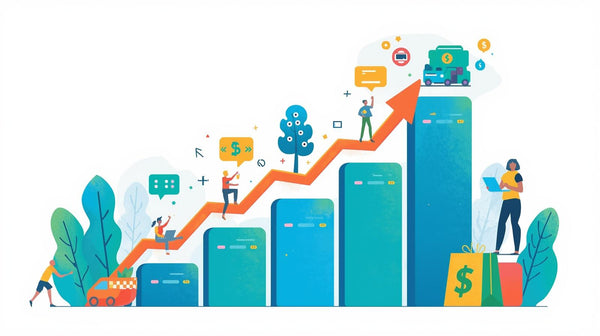What is Analytics in E-commerce?
Analytics in e-commerce is the systematic process of collecting, measuring, and analyzing data generated by your online store. This data includes everything from how visitors interact with your website, to their purchasing habits, marketing campaign effectiveness, and overall customer engagement.
For Shopify store owners, analytics acts as a crucial feedback loop helping you understand exactly what’s happening behind the scenes. It tracks customer behavior such as:
-
Which pages they visit
-
How long they stay on your site
-
Which products they view or add to their cart
-
What ultimately drives them to complete a purchase
Beyond just customer actions, e-commerce analytics also covers:
-
Monitoring sales trends over time
-
Highlighting which marketing channels deliver the best return on investment (ROI)
-
Measuring key performance indicators (KPIs) like conversion rates and average order value
Shopify provides built-in analytics tools that offer valuable insights on:
-
Sales performance
-
Customer demographics
-
Traffic sources and patterns
Many successful Shopify merchants complement these with advanced third-party platforms such as:
-
Google Analytics for deep traffic and behavior analysis
-
Facebook Pixel for ad tracking and retargeting
-
Specialized apps that provide user journey mapping and marketing attribution
Ultimately, the goal of e-commerce analytics is to:
-
Uncover behavioral patterns
-
Spot growth opportunities
-
Identify challenges early
This allows you to optimize your store’s performance, tailor your marketing strategies, and deliver a better shopping experience that drives sustainable growth and profitability.

Why Analytics Matters for Shopify Store Owners
Analytics is the secret weapon that transforms guesswork into smart business decisions for Shopify store owners. Understanding and using analytics effectively lets you gain a competitive edge by revealing exactly what’s happening in your store and why. Here’s why analytics should be a cornerstone of your e-commerce strategy:
1. Understand Your Customers
Analytics shows you detailed insights about who’s visiting your store, where they come from, what devices they use, and most importantly, what products they’re interested in. Knowing your customers’ behavior like which pages they browse, how long they stay, and what leads them to purchase helps you tailor your offerings and marketing messages to meet their needs better.
2. Optimize Marketing Campaigns
With analytics, you can track the performance of every marketing campaign you run from social media ads to email blasts. This lets you pinpoint which channels and ads deliver the highest return on investment (ROI), so you can focus your budget on the most effective strategies and cut wasteful spending.
3. Improve Conversion Rates
Not every visitor buys right away. Analytics helps identify where shoppers drop off in your sales funnel, such as the product page, checkout, or payment process. With this insight, you can troubleshoot friction points, optimize user experience, and ultimately convert more browsers into buyers.
4. Smarter Inventory Management
Tracking which products sell well and which don’t is essential for managing stock efficiently. Analytics helps you spot best-sellers to keep well-stocked and slow movers that may need discounts or removal. This prevents costly overstocking or stockouts that can frustrate customers.
5. Gain Financial Insights
Analytics lets you monitor critical financial metrics like revenue, costs, and profit margins in real time. Understanding these numbers helps you price products correctly, forecast revenue, and maintain profitability as your store grows.

Why It Matters
Without analytics, decisions become based on guesswork or gut feelings, increasing the risk of wasted time, budget, and missed opportunities. Leveraging data-driven insights allows you to make smarter, faster, and more confident decisions that directly impact your Shopify store’s success.
Key Types of Analytics You Should Track
To effectively manage and grow your Shopify store, it’s crucial to monitor several key types of analytics. Each category provides valuable insights into different aspects of your business, helping you make informed decisions that drive sales and improve customer experience. Here’s a detailed breakdown of the essential analytics you should track:
1. Traffic Analytics
Traffic analytics reveal where your visitors are coming from whether it’s organic search, paid ads, social media, or direct visits. You also get data on the devices they use (mobile, desktop, tablet) and how long they stay on your site. Understanding traffic sources and user behavior helps you focus your marketing efforts on channels that bring in quality visitors more likely to convert.
2. Sales Analytics
Sales analytics track your total revenue, average order value (AOV), and conversion rates. These metrics show how well your store is performing financially. For example, a high AOV means customers are buying more per transaction, which can be encouraged through upselling or bundling strategies. Conversion rates indicate the percentage of visitors who complete a purchase, signaling how effective your website and marketing are at closing sales.
3. Customer Behavior Analytics
This type of analytics dives into how customers interact with your site. It includes page views, click paths (the sequence of pages visitors browse), and cart abandonment rates. High cart abandonment could mean issues with your checkout process or unexpected costs like shipping fees. By analyzing these behaviors, you can identify and fix friction points to enhance user experience and increase conversions.
4. Marketing Performance Analytics
Marketing analytics compare your advertising spend against the revenue generated, helping you calculate the return on investment (ROI) for each marketing channel. You’ll see which campaigns, platforms, or audiences deliver the best results and which ones may need adjustment or discontinuation. This insight ensures you allocate your marketing budget effectively to maximize growth.
5. Product Analytics
Product analytics focus on individual item performance tracking which products sell best, their profit margins, and how often they’re viewed. Knowing your best-sellers allows you to stock appropriately and promote these items, while identifying slow movers helps you plan discounts or phase them out to free up resources.
6. Customer Retention Analytics
Tracking customer retention metrics such as repeat purchase rates and customer lifetime value (CLV) provides insight into the long-term health of your business. High retention means satisfied customers coming back, which is generally more cost-effective than acquiring new ones. Analytics here help you create loyalty programs and targeted campaigns to boost repeat sales.

Why Track These Analytics?
Monitoring these six key areas paints a comprehensive picture of your Shopify store’s health. They allow you to identify strengths, spot weaknesses, and uncover opportunities. By regularly reviewing this data, you can optimize your operations, marketing, and product offerings to drive sustainable growth.
How to Set Up Analytics for Your Shopify Store
Setting up analytics properly on your Shopify store is essential for collecting accurate and actionable data. Without a well-configured analytics system, you risk making decisions based on incomplete or misleading information. Here’s a step-by-step guide to help you set up the right analytics tools and start gaining insights from day one:
1. Use Shopify Analytics for Basic Reporting
Shopify comes with built-in analytics that provide a solid foundation for tracking sales, customer demographics, and marketing performance. Through the Shopify dashboard, you can access reports on total sales, traffic sources, conversion rates, and customer behavior. These reports are user-friendly and ideal for beginners looking to monitor key store metrics without additional setup.
2. Connect Google Analytics for Deeper Insights
Google Analytics is a powerful, free tool that offers advanced tracking beyond Shopify’s default reports. By integrating Google Analytics with your Shopify store, you can track detailed visitor behavior, traffic sources, user demographics, and conversion funnels. It allows you to see exactly how visitors navigate your site and identify potential bottlenecks in the purchase process. Setting up Google Analytics also enables ecommerce tracking, which provides specific data about transactions and revenue.
3. Install Facebook Pixel or TikTok Pixel to Track Ad Effectiveness
If you’re running ads on platforms like Facebook, Instagram, or TikTok, installing their respective tracking pixels on your Shopify store is crucial. These pixels collect data on user actions after clicking your ads, such as adding items to carts or completing purchases. This data helps optimize your ad targeting, measure campaign performance, and run effective retargeting campaigns that boost conversions and reduce wasted ad spend.
4. Use Apps Like Hotjar for Heatmaps and Session Recordings
Understanding how visitors interact with your site visually can reveal hidden pain points. Tools like Hotjar provide heatmaps that show where users click, scroll, or hesitate on your pages. Session recordings let you watch real visitor sessions to observe navigation patterns, confusion, or frustration. This qualitative data complements your quantitative analytics and helps improve site usability and conversion rates.
5. Set Clear KPIs Aligned with Your Business Goals
Before diving into data, it’s important to define the Key Performance Indicators (KPIs) that matter most to your store. KPIs could include metrics like conversion rate, average order value, customer acquisition cost, or repeat purchase rate. Setting clear KPIs ensures you focus on data that aligns with your growth objectives and can track progress effectively over time.

Why Proper Setup Matters
Accurate and reliable data starts with correct analytics setup. Misconfigured tools can lead to incomplete or misleading reports, causing poor decision-making. Investing time upfront to connect and configure your analytics properly sets the foundation for confident, data-driven growth.
Advantages of Using Analytics for Your Shopify Business
Leveraging analytics in your Shopify store is not just about tracking numbers; it’s about transforming data into a powerful engine for growth. When used correctly, analytics offers multiple advantages that directly impact your sales, marketing, and customer experience. Let’s dive deep into the key benefits of using analytics for your Shopify business.
1. Data-Driven Decisions: Move Away from Guesswork with Real Facts
One of the biggest advantages of analytics is the ability to replace gut feelings and assumptions with concrete data. Instead of guessing which products or campaigns work, analytics provides clear evidence of what’s successful and what’s not. This empowers you to make decisions based on facts, reducing risks and increasing the likelihood of positive outcomes. For Shopify store owners, this means smarter product launches, better pricing strategies, and more effective marketing campaigns.
2. Boosted Marketing Efficiency: Spend Smarter by Focusing on Channels That Convert
Marketing budgets can quickly get wasted on underperforming ads or ineffective platforms. Analytics helps you identify which marketing channels and campaigns bring the best return on investment (ROI). Whether it’s Google Ads, Facebook, TikTok, or email marketing, analytics shows you where your money is best spent. By reallocating budget to high-performing channels, you can increase customer acquisition while lowering overall marketing costs a crucial factor for scaling Shopify stores sustainably.

3. Improved User Experience: Identify and Fix Website Issues Causing Drop-Offs
Customer behavior analytics allow you to understand how visitors interact with your website. Are they abandoning their carts on the checkout page? Are product pages loading slowly or causing confusion? Analytics tools like heatmaps and session recordings reveal friction points that prevent visitors from completing purchases. By addressing these issues, you create a smoother, more enjoyable shopping experience that keeps customers engaged and boosts conversion rates.
4. Higher Sales: Target Promotions and Optimize Product Offerings
Analytics gives you insights into which products are your best sellers and which ones aren’t resonating with customers. This information allows you to optimize your product catalog, bundle complementary products, and create targeted promotions that appeal to your audience’s preferences. Personalized recommendations and dynamic pricing based on analytics can significantly increase average order values and overall revenue for your Shopify store.
5. Better Forecasting: Predict Demand and Manage Inventory to Avoid Stockouts
Inventory management is a delicate balance between meeting demand and minimizing storage costs. Analytics helps forecast product demand by analyzing sales trends, seasonality, and customer behavior. With accurate predictions, you can stock the right products in the right quantities, reducing the risk of stockouts that disappoint customers or overstock that ties up capital. Efficient inventory management driven by analytics leads to smoother operations and better cash flow management.
6. Increased Customer Loyalty: Personalize Offers Based on Buying Patterns
Customer retention is often more profitable than acquiring new customers. Analytics helps you understand repeat purchase rates and customer lifetime value (CLV), allowing you to segment your audience and create personalized marketing campaigns. Tailored offers, loyalty programs, and targeted communication based on past purchases increase customer satisfaction and foster long-term relationships, turning buyers into brand advocates.

Why These Advantages Matter
For Shopify store owners, analytics is not a luxury it’s a necessity. It turns your store from a simple online presence into a data-powered business that learns, adapts, and grows. With the insights analytics provides, you can streamline operations, sharpen marketing strategies, and build deeper connections with customers all essential for thriving in today’s competitive e-commerce landscape.
How to Use Analytics to Improve Your Shopify Store
Using analytics effectively means turning raw data into actionable strategies that enhance your store’s performance. Here are key ways to leverage analytics to optimize different aspects of your Shopify business:
1. Analyze Traffic Sources
Not all traffic is created equal. Analytics helps you identify which marketing channels whether it’s organic search, social media, paid ads, or email bring in the most valuable visitors who convert into buyers. Focus your efforts and budget on these profitable channels to maximize your return on investment and reduce wasted spend on low-performing sources.
2. Monitor Cart Abandonment
Cart abandonment is a major hurdle for many Shopify stores. Analytics reveals where customers drop off in the checkout process, whether it’s on shipping options, payment methods, or unexpected costs. Use these insights to optimize your checkout flow by simplifying steps, offering multiple payment options, and crafting targeted recovery emails or retargeting ads that encourage customers to complete their purchase.

3. Segment Customers
Not all customers behave the same. Analytics lets you segment your audience based on demographics, purchase history, and browsing behavior. This segmentation enables you to tailor your marketing campaigns such as personalized emails, special offers, or product recommendations so they resonate better with each group, increasing engagement and conversions.
4. Test & Learn
Analytics is the foundation for effective A/B testing. Use it to test different product page layouts, ad creatives, pricing strategies, or email subject lines. Compare performance data to learn what works best and continuously refine your store’s elements. This iterative approach ensures you’re always improving user experience and boosting sales.
5. Track Product Performance
Use analytics to identify which products are your best sellers and which ones underperform. Discontinue or discount slow movers to free up resources and inventory space. Promote top sellers more aggressively with upselling or bundling strategies to increase average order value and overall revenue.
6. Measure Marketing ROI
Track how much you spend on each marketing channel versus the revenue it generates. This helps you adjust budgets dynamically, investing more in high-return campaigns and cutting back on underperforming ones. Continuous ROI measurement ensures your marketing budget is always optimized for maximum growth.

Continuous Monitoring and Adjustment
The key to success with analytics is ongoing review and adaptation. Markets, customer preferences, and technology change constantly, so your store must evolve too. Regularly monitor your analytics dashboards, set alerts for anomalies, and adjust your strategies based on data-driven insights to stay competitive and profitable.
Essential Analytics Tools for Shopify Sellers
Tracking and analyzing your Shopify store’s performance requires the right tools. Fortunately, a range of analytics platforms and apps are available to help you gather data, understand customer behavior, and optimize your marketing efforts. Here’s a breakdown of some essential analytics tools every Shopify seller should consider:
1. Shopify Reports & Dashboards
Shopify offers built-in reports and dashboards that are user-friendly and ideal for beginners. These tools provide valuable insights on sales, customer demographics, traffic sources, and marketing campaigns all accessible directly from your Shopify admin panel. For store owners starting out, Shopify’s native analytics are a great way to get a clear picture of your store’s health without needing external tools.
2. Google Analytics
Google Analytics is a powerful, free tool that delivers deep insights into your store’s traffic and visitor behavior. Beyond basic pageviews, it tracks user journeys, conversion funnels, referral sources, and much more. With Google Analytics ecommerce tracking enabled, Shopify sellers can see detailed reports on transactions, revenue, and customer interactions, enabling data-driven marketing and optimization decisions.

3. Facebook Pixel
For those advertising on Facebook and Instagram, installing the Facebook Pixel on your Shopify store is essential. This tracking code collects data on user actions after clicking your ads, allowing you to optimize campaigns, create custom audiences, and run effective retargeting ads. Facebook Pixel helps maximize ad spend efficiency and increase conversion rates through smarter targeting.
4. Hotjar
Hotjar complements quantitative analytics by providing visual insights into visitor behavior. It offers heatmaps that show where users click, scroll, and hover, as well as session recordings that replay individual user visits. These tools help identify usability issues, navigation problems, or confusing page elements that may be affecting conversions, enabling you to improve the shopping experience.
5. Klaviyo
Klaviyo is an email marketing platform tailored for e-commerce, with robust analytics on email campaign performance. Shopify sellers can track open rates, click-through rates, revenue generated from emails, and customer segmentation. This data helps craft personalized and automated email campaigns that drive repeat sales and increase customer lifetime value.
6. Lucky Orange
Lucky Orange is another tool for understanding user experience through session recordings, live chat, and conversion funnels. It allows you to watch exactly how visitors interact with your site in real time or via recordings, spotting pain points that may not appear in traditional analytics. This qualitative data is invaluable for optimizing your Shopify store’s design and checkout flow.

Choosing the Right Mix for Your Business
The right analytics toolkit depends on your store’s size, complexity, and goals. Beginners may start with Shopify’s built-in reports and Google Analytics for a comprehensive overview. As your business grows, adding specialized tools like Facebook Pixel, Hotjar, Klaviyo, or Lucky Orange can provide deeper insights and optimization opportunities.
Integrating these tools effectively ensures you have a full understanding of your Shopify store’s performance from traffic acquisition to customer behavior to sales conversion helping you make smarter decisions that fuel growth.

How EcomSpiders Can Help with Shopify Analytics
At EcomSpiders, we understand that analytics can be overwhelming raw data by itself doesn’t create results. What matters is how you set up, interpret, and act on that data to grow your Shopify store effectively. That’s where our expertise comes in.
1. Configure Shopify and Third-Party Analytics Tools Correctly
We help you seamlessly connect and configure Shopify’s native analytics along with powerful third-party tools like Google Analytics, Facebook Pixel, TikTok Pixel, Hotjar, and more. Proper setup is critical to ensure your data is accurate and comprehensive, so you can trust your reports and insights without second-guessing.
2. Identify the Most Important KPIs Tailored to Your Business
Every Shopify store is unique. We work closely with you to define and prioritize the Key Performance Indicators (KPIs) that matter most for your specific goals whether it’s increasing average order value, improving customer retention, or maximizing ad ROI. This focused approach helps you measure what truly impacts your bottom line.
3. Analyze Data to Provide Clear, Actionable Reports
Data is only useful if it’s understandable. Our team dives into your analytics data, distilling complex metrics into clear, easy-to-understand reports. We highlight trends, pinpoint areas for improvement, and recommend specific actions helping you make informed decisions without getting lost in numbers.
4. Optimize Marketing Campaigns and Product Listings Based on Insights
Using analytics insights, we refine your marketing strategies and product catalog. Whether it’s reallocating ad budgets to top-performing channels, tweaking product descriptions to increase conversions, or identifying new audience segments to target, we ensure your efforts are laser-focused and effective.
5. Implement Tracking Pixels and Conversion Funnels for Better ROI
We handle the technical side of setting up tracking pixels and conversion funnels across multiple platforms. This ensures you can monitor user journeys end-to-end from first ad impression to final purchase enabling you to optimize campaigns continuously and maximize return on investment.
6. Ensure Compliance with Data Privacy Laws
Data privacy regulations like GDPR and CCPA are critical to respect and comply with. We help you implement analytics tracking in ways that protect your customers’ privacy and keep your store compliant with legal requirements, avoiding costly penalties and building trust with your audience.
Turning Raw Data into Real Growth
At EcomSpiders, our mission is to transform your analytics from confusing numbers into a clear roadmap for growth. By combining technical expertise, strategic insight, and hands-on support, we empower Shopify store owners to make smarter decisions, boost sales, and scale with confidence.

Final Thoughts & Free Consultation Offer
Analytics is far more than just a technical tool it’s a strategic advantage that can set your Shopify store apart in today’s fiercely competitive e-commerce landscape. When you know how to properly collect, interpret, and act on your data, you gain a clear roadmap for growth that drives smarter decisions, increases sales, and enhances the customer experience.
But we understand that for many Shopify store owners, analytics can feel overwhelming. Between setting up the right tools, understanding complex reports, and knowing which metrics truly matter, it’s easy to get stuck or miss out on valuable opportunities.
That’s exactly why EcomSpiders is here. Our team specializes in helping Shopify merchants unlock the full potential of analytics without the confusion or guesswork. We provide hands-on guidance to assess your current analytics setup, identify gaps, and recommend tailored improvements designed to deliver measurable results.
What We Offer in Our Free Consultation:
-
A thorough evaluation of your Shopify analytics and tracking tools
-
Clear explanations of your store’s key metrics and insights
-
Customized recommendations to optimize data collection and reporting
-
Strategies to leverage analytics for better marketing, sales, and inventory decisions
-
Answers to your questions and expert advice tailored to your business goals
Taking advantage of our free consultation is the first step toward turning raw data into actionable insights that fuel your Shopify store’s success.
Don’t leave growth to chance. Contact EcomSpiders today to schedule your free session and start making smarter, data-driven decisions that take your business to the next level.





0 comments